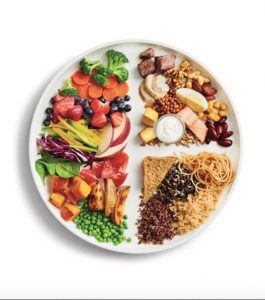
Does this sound like a familiar scenerio: you decide that you want to start eating healthier and immediately your mind goes to boring food that the media has deemed healthy, and you start saying good-bye to all of the foods you enjoy eating. Good-bye french fries and hello to boring salad of ice berg lettuce and two cherry tomatoes. Seem about right?
Or perhaps you have a pretty good handle on preparing healthier options. You genuinely enjoy whole food options, but sometimes you wonder if the proportion of all the ingredients on your plate is right. Maybe you create a really enjoyable meal, but then you find you are hungry just a few hours later. Creating meals that are healthy and enjoyable does not have to be a guessing game and shouldn’t be a secret reserved only for people who we deem to be the epitome of health. It can be done easily by using a simple guide and building your meal around these ideas. Take the guessing and stress out of your meals, and start enjoying them again.
Step 1: Fill half your plate with vegetables
Vegetables are full of vitamins, nutrients, and fiber. Vitamins are vital for the proper functioning of your body. Additionally fiber is an amazing nutrient that aids in feeling full for longer. Veggies will add volume to your plate without loads of extra calories. Try to add as many colors as you can to get a wide variety of different vitamins and antioxidant. The deeper the color, the richer the antioxidants.
Step 2: Fill a quarter of your plate with protein
Proteins are the building blocks of your body and they are another important component to feeling fuller for longer. Animal sources are chicken, eggs, beef, turkey, and Greek yogurt. Plant protein sources can be found in beans, tofu, tempeh, quinoa, nuts and seeds.
Step 3: Fill a quarter of your plate with carbohydrates
Carbohydrates provide the body with energy and help you feel satisfied. Look for whole food sources of carbohydrates that are minimally processed. Whole grains such as oats, brown rice, quinoa, millet and whole grain bread are great sources. There are so many different kinds of whole grains out there, experiement by trying something new! Starchy vegetables also fit into this category such as potatoes, yams, beans, corn, peas, and winter squashes.
Step 4: Finish it off with a little bit of fat
Fats are important for your body and help with satiety. Top off your meal with your favorite source of fat such as avocado, a delicious tahini dressing, a sprinkling of nuts and seeds, maybe a drizzle of high quality olive oil, or a bit of cheese. Fats are not the enemy, and you should certainly not be afraid to enjoy them with your meal.
Now that you have the building blocks of a well balanced meal in place, think about what foods you enjoy that fit into these categories and start cooking! Be creative, think outside the box, and enjoy your meals and the steps you are taking toward investing in your health.
